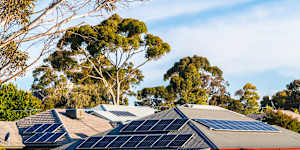When the local council put them in landfill,Tim Dawson heard about it and took the panels to his mate James Petesic’s garage.

By 2023,Australia will have installed 100 million solar panels - enough to pile as high as 480 Mount Everests.Getty
There,the pair pulled them apart to recycle the materials,turning the exercise into a business.
By next year,Australia will have installed 100 million solar panels – or enough to pile as high as 480 Mount Everests.
“This is a massive challenge to solve because of the sheer scale,” Dawson warns.
“It’s easy enough to take care of consumer electronics,taking them to your local recycling centre,but it’s a lot harder to take your 12 solar panels and get them recycled.”
The International Energy Agency has forecast that Australia will have one of the biggest solar waste streams in the world in the wake of a solar boom that began more than a decade ago.
Although battery waste is expected to grow at a faster rate than solar panels because of a shorter life span,panels will make up the bulk of the problem.
Sustainability Victoria has estimated 100,000 tonnes of panels will become waste by 2035 Australia-wide,but there is also scope for the development of new markets and manufacturing using the valuable materials.
Ways to collect,use and process the waste will need to be developed,particularly for glass – which makes up most of a solar panel by weight.
“Right now,most of those solar panels that reach end of life go to landfill,” Dawson told a recent conference.
Tackling the gargantuan challenge,his business PV Industries has set up drop-off points available to the public in Sydney and Melbourne.
The firm provides a one-stop shop for recycling the panels,inverters,cables and the rooftop framework systems are mounted on,handling both household and larger-scale set-ups.
For example,one sports centre had installed a system in 2010 but realised solar technology had since become more powerful and efficient.
A decision was made to upgrade from a 15-kilowatt to 55kW system by installing better panels and recycling the old array.
“It’s pretty simple really,” Dawson said.
“We collect the solar panels,recover the materials to their highest possible value and then we sell those materials for use in local manufacturing to make new products.”
PV Industries has also developed equipment for deglassing and deframing.
The NSW government this year provided the firm $2.3 million to scale up the recycling technology and build a solar panel and battery recycling facility,which will process up to 8000 tonnes of waste a year.
The “circular solar” grants are the start of a so-called circular economy for panels and batteries through which materials get recycled and reused rather than being dumped.
PV Industries is also working to educate installers,councils and state governments to think about re-use,repairs and recycling when installing systems for homes and neighbourhoods.
And it has branched out to add batteries,before another mountain of waste builds up.
AAP